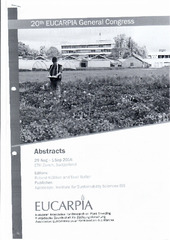| dc.creator | Hristov, N. | |
| dc.creator | Mladenov, N. | |
| dc.creator | Kondić-Špika, Ankica | |
| dc.creator | Marjanović-Jeromela, Ana | |
| dc.creator | Grahovac, Nada | |
| dc.creator | Jocković, Bojan | |
| dc.creator | Aćin, Vladimir | |
| dc.creator | Mirosavljević, Milan | |
| dc.creator | Momčilović, V. | |
| dc.date.accessioned | 2023-08-17T08:00:02Z | |
| dc.date.available | 2023-08-17T08:00:02Z | |
| dc.date.issued | 2016 | |
| dc.identifier.isbn | 978-3-906804-22-4 | |
| dc.identifier.uri | http://fiver.ifvcns.rs/handle/123456789/3719 | |
| dc.description.abstract | Wheat is one of the most widespread plant species, primarily because of its adaptability and
diverse uses. Increased application of wheat oil in food, beauty and pharmaceutical industries
has led to an increased importance of oil content as an indicator of quality. Wheat oil has
beneficial effects on human health due to its high content of tocopherols and polyunsaturated
fatty acids. The most important chemical traits of tocopherols are their antioxidant activities
and biological function in vitamin E activities. The aim of this study was to determine the variability of oil and tocopherols content in 24 genetically divergent wheat cultivars from
different selection cycles during a two-year period. The oil was extracted from wheat bran
obtained by using laboratory mill MLU 202. The classic Rushkovsky method was used to determine the oil content, while tocopherols (a, B y) were simultaneously determined using
hexane extraction and liquid chromatography with detection of fluorescence. The average oil content during two years ranged from 4.1% to 4.3%, while the minimum and maximum
values ranged from 3.2% to 4.9%. The coefficient of variation (CV) value was 8.6%. The
average content of a tocopherols during two years ranged from 9.1 to 13.1 mg/kg bran (min.
and max. values: 3.8-18.5 mg/kg bran), 8 tocopherols 6.5-8.2 mg/kg bran (min. and max.
values: 2.9-11.1 mg/kg bran) and y tocopherols 31.1-53.0 mg/kg bran (min. and max. values:
29.2-67.4 mg/kg bran). The CVs for the contents of a, B and y tocopherols were 8, 4.6 and 3.4%, respectively. The effect of genetic factors and environment (and their interaction), were
highly significant for all analysed parameters, and highly significant correlations were found
between them (correlations varied from 0,871** between oil content and y tocopherols to 0.990** between o and B tocopherols). Cluster analysis showing the degree of similarities was used to group the analysed varieties into clusters, which can serve as the basis for the selection of parental components to further the wheat breeding for higher oil content and quality. The results obtained from wheat bran have shown lower oil content and higher
content of y tocopherols in relation to the direct extraction from the wheat germ. Varieties with higher oil and tocopherol content can be used as a good raw material for whole-wheat
products with important benefits to the human health.
This study was conducted as part of the Projects No. TR 310 | sr |
| dc.language.iso | en | sr |
| dc.publisher | Agroscope, Zurich, Switzerland | sr |
| dc.relation | info:eu-repo/grantAgreement/MESTD/Technological Development (TD or TR)/31066/RS// | sr |
| dc.rights | openAccess | sr |
| dc.rights.uri | https://creativecommons.org/licenses/by/4.0/ | |
| dc.source | 20th EUCARPIA General Congress „Plant Breeding the Art of Bringing Science to Life“, Zurich, Switzerland, 29 August | sr |
| dc.subject | wheat | sr |
| dc.subject | oil content | sr |
| dc.subject | tocopherols | sr |
| dc.subject | cultivars | sr |
| dc.title | Variability of oil and tocopherol content in wheat | sr |
| dc.type | conferenceObject | sr |
| dc.rights.license | BY | sr |
| dc.citation.epage | 167 | |
| dc.citation.spage | 167 | |
| dc.identifier.fulltext | http://fiver.ifvcns.rs/bitstream/id/9232/bitstream_9232.pdf | |
| dc.identifier.rcub | https://hdl.handle.net/21.15107/rcub_fiver_3719 | |
| dc.type.version | publishedVersion | sr |


